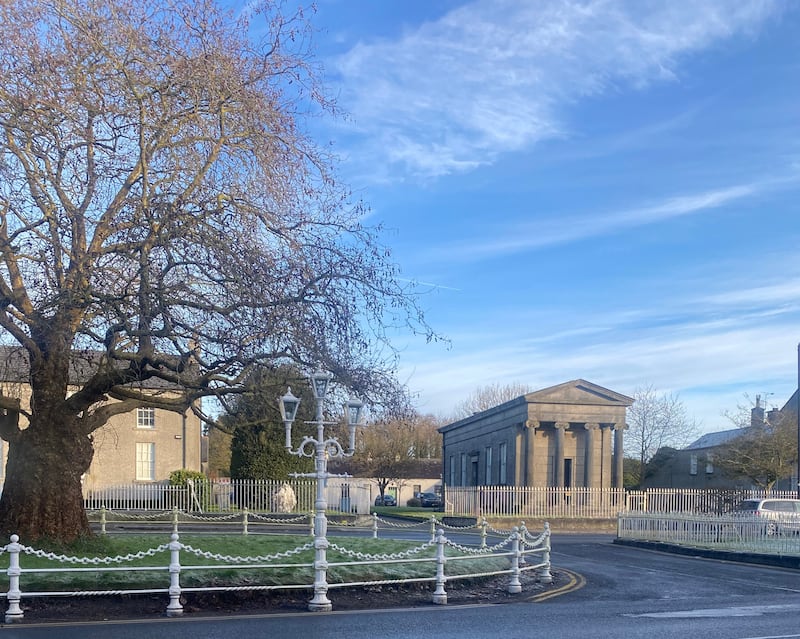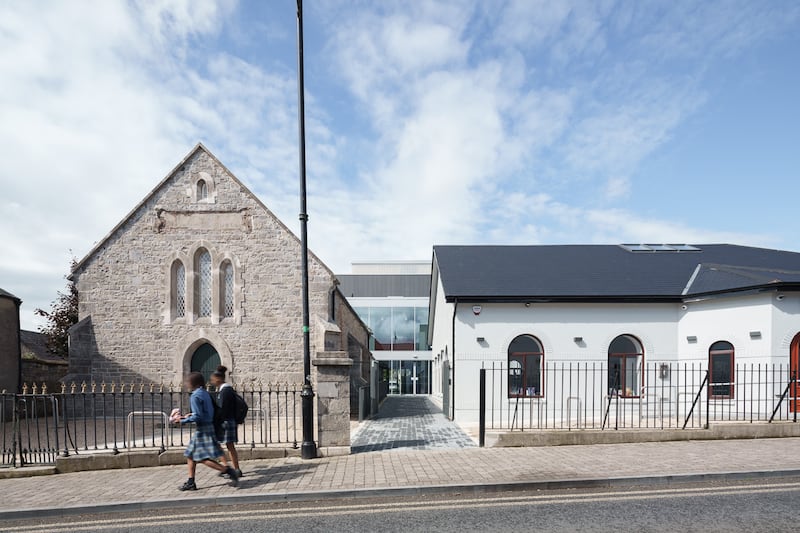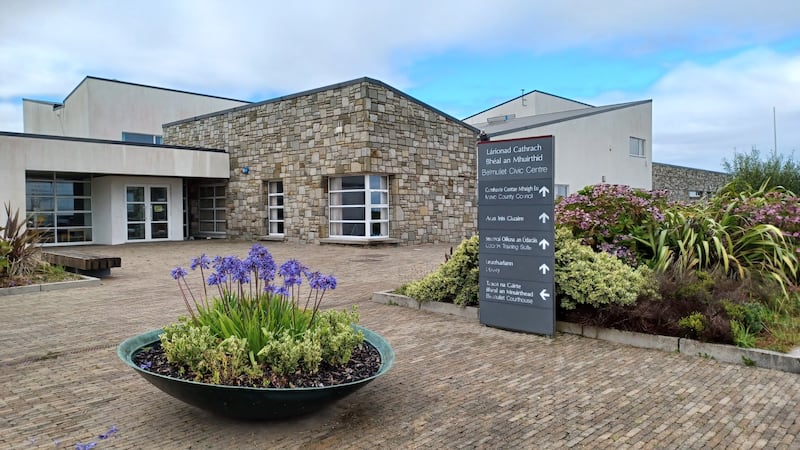In the midst of the housing crisis, imagine if there was a stock of property, already built and serviced with infrastructure, including shops, schools, health centres, community centres, sports grounds and parks.
Then imagine if these homes were clustered around some of the finest civic squares in Europe, often containing graceful buildings with arched entrances to hidden gardens and yards. Welcome to small town Ireland, ready and waiting, it has been hiding in plain sight.
Why, then, do our rural towns continue to decline?
Architect Valerie Mulvin of McCullough Mulvin estimates they contain approximately 90,000 potential homes, and her exhibition, The Reason of Towns, offers solutions for revival.
Alzheimer’s: ‘I’ve lost my friend and my companion,’ says Úna Crawford O’Brien of fellow Fair City actor Bryan Murray
Ryan Adams at Vicar Street: A gig that nobody will forget anytime soon, but perhaps not for all the right reasons
Meghan Markle’s new podcast: An ego-fluffing conversation underlining the culture gap between Ireland and the US
The problems are obvious. Years of neglect have not helped and neither has the tendency of developers to prefer large multi-unit housing projects and retail parks on brownfield sites. Years of thinking influenced by short-term profit, rather than long-term social stability has squandered opportunities. Bypasses have brought people to the edges, to the detriment of communities.
All this we know. It is tempting to feel a sense of powerlessness, but there is hope. In 2021, Mulvin published a book, Approximate Formality: Morphology of Irish Towns, a sort of love letter to the rural Irish town, and noted that the Covic-19 pandemic and remote working had returned a rural focus, adding that “the conservation and sustainable development of Irish towns to provide homes for thousands of additional people could, if answered originally, be Ireland’s significant contribution to world culture for the next number of years”.
Does this sound a little grandiose?
Just look at Templemore, Co Tipperary, an aerial shot of its main square features on the cover of Approximate Formality. Lined with commercial premises and houses, many of which are shuttered, the square is on the path of the main N62 route. According to Mulvin, just a handful of people lived on it.
Then, compare it with similar spaces in Europe that are pedestrianised, creating parks and offering safe places for kids to play, to walk to school, for shared urban gardens, for a community to come together. You might even grow vegetables. How quickly might those empty buildings become desirable then?
At the exhibition, a film, The Space is the Thing, focuses on the potential of Templemore; Clones, Co Monaghan; Youghal, Co Cork and Dungarvan, Co Waterford. Mulvin counted more than 100 vacant shops on the Main Street of Youghal, a graceful and historic walled town on the Copper Coast, at the estuary of the River Blackwater. Of these towns, only Dungarvan, again with a beautiful square, has a population today greater than it did pre-Famine.

A second film, Of Pride and Place looks at more optimistic stories. Conservation Architect Duncan McLaren describes restoration works in Ramelton, Co Donegal that included combining smaller homes, using such calamities as collapsed roofs to create internal winter gardens, and restoring facades to encourage future use. The film also explores projects in towns including Westport, Co Mayo; Roscommon, Corofin, Co Clare and Co Cork’s Bantry and Cobh.
All this fits in with the sustainability agenda, as embodied carbon in pre-existing buildings should put their reuse to the fore of planning considerations. McCullough Mulvin have expertise in this and, as I have written about before, Mulvin’s late husband and practice partner Niall McCullough designed my own home conversion.
Funds such as the vacant and derelict property grants from the Croí Cónaithe scheme make such projects more viable, but there are still plenty of barriers.
What five things does Mulvin suggest would be crucial to unlocking the potential of some of our more forgotten towns and all the housing spaces they contain?
“The first is people wanting to live there,” she says.
“That’s the biggest mindset change. Many people think they need to have a suburban existence, with a car that can be parked in the front garden.”
Cars are, and will be, a fact of life in the short-term future at least, but as her film, The Space is the Thing, demonstrates, many buildings in Ireland’s country towns date from the days when people needed yards for a horse and cart, and these neglected back spaces can become off-street car parks, freeing up our streets and squares for communities to use safely. Prices are affordable too. If we create enough desire, it can drive vital change.
“You could buy a whole building, or two together, knock through and divide them horizontally, so that two or three families could have large apartments,” says Mulvin. “But it’s hard to get companies to insure buildings like that.”
This leads to Mulvin’s second crucial change: access to information and support.

“People are daunted by the whole process of approaching their local authority for a project like that, and can be confused by all the various schemes.”
Local authorities should create clinics where you can avail of advice and support from the town architect, conservation architect, the planning and fire departments together.
“We have researched it, and a project like this is relatively inexpensive, and can create huge spaces for loft-style living. Local authorities,” she continues “are often not adventurous enough, so a lot of this needs to come from people wanting to do things. When people move back into these towns, they will become vibrant communities again.”
Thirdly, the Government needs to appoint a county architect in every single county.
“They don’t all have them yet. You should also have a conservation architect and a heritage officer in every local authority to add a sense of what is valuable about all the parts of a town.”
Fourthly, Mulvin says: “Local authorities and the Government need to be proactive in working with banks and insurance companies to help these things to happen. It has to be possible, and people have to see that it is.”
Finally, there needs to be an investment in the upskilling of people to make the ambitious plans a reality.
“There are a whole range of skills that are either disappearing, or already gone. Masons, slaters, people who make windows, people who repair things. We need to train people again.”

Some of this hinges on moving away from the belief that you need degree-level education to do anything useful, and to place a greater emphasis on the importance of the various trades and manual skills.
A section of The Reason of Towns exhibition, Fragments, includes examples of beautifully-made items, such as cornices, windows and pediments, the detritus of demolition and dereliction.
“These towns in Ireland, they are exactly the same as some of the finest European towns. And we could make them really fine, if we had more people living in them. I am optimistic,” Mulvin concludes. “There are more people around with vision than there were 20 years ago.”
The Reason of Towns is at John’s Hall, Birr until August 11th. Presented as part of Birr Vintage Week and Arts Festival, A Talks of the Town event takes place today, August 10th, including a walking tour, workshop and talks. The exhibition tours to Belmullet from August 16th to 30th, and Trim from September 12th to 26th. Approximate Formality is published by Anne Street Press (€35) mcculloughmulvin.com.
The Reason of Towns is part of a series of Irish Architecture Foundation Reimagine projects aimed at exploring sustainable solutions to the housing crisis.
Reimagine Place: includes online guides and resources to help address local issues such as shared space, accessibility and inclusion, and giving new life to old buildings.

Hometown Architect: links architects with community groups to propose new solutions to long-term problems. In 2023 five projects addressed vacancy and dereliction in Tuam and Tipperary Town, accessibility in Aughrim, community spaces in Belmullet, and wellbeing in Lisdoonvarna. This year, the focus is on a vacant town centre site in Bailieborough, reconnecting Mountrath with the Whitehorse River, and revitalising the heritage town of Moville.
Housing Unlocked: running from October 2022 to February 2023, the Housing Unlocked exhibition showcased eight architect-led proposals, including ideas to convert vacant churches, shops and bank buildings into homes, modular living cubes, and 100 small hacks to revitalise a town, online at housingunlocked.ie.
gaplab: a new programme gives placements to graduate architects to develop new ideas in their communities.
The projects have been supported by the Arts Council, Creative Ireland, the Department of Rural and Community Development, and the Department of Housing, Local Government and Heritage.




















